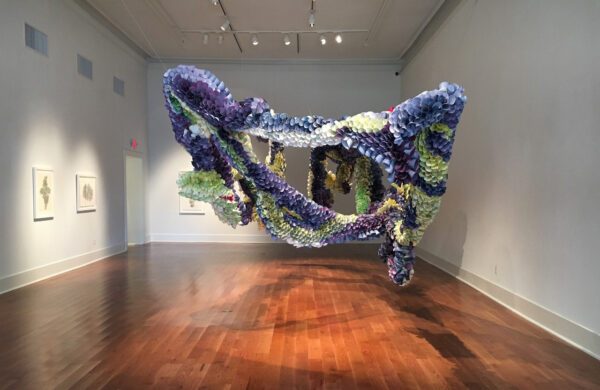
Abhidnya Ghuge, “Changing Perspectives,” 2017, at the Galveston Arts Center. Image courtesy of the artist
Born and raised in Mumbai, Abhidnya Ghuge, who immigrated to the United States in 1993, now calls Tyler, Texas home. Ghuge is widely known for her site-responsive installations, and her work is layered with hints of her own personal history intertwined with visual explorations of universal themes, such as community, labor and value.
Ghuge’s work has been featured in numerous solo and group exhibitions throughout the United States. Most recently, one of her installations was part of the 2021 Texas Biennial at the San Antonio Museum of Art.
Recently, the artist and I visited about her work and overall process.
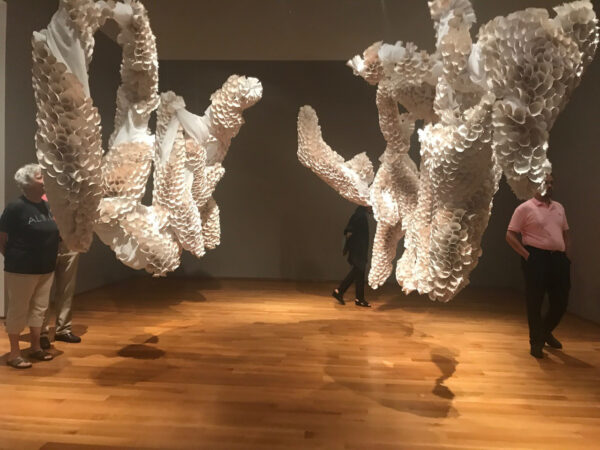
Abhidnya Ghuge, “Immersion,” 2019, 8047 woodblock printed paper plates, wire and fabric, installed at Asia Society Texas Center as part of “Site Lines: Artists Working in Texas.” Image courtesy of the artist
Caleb Bell (CB): Before we discuss your work, could you share a little bit about your artistic journey?
Abhidnya Ghuge (AG): As a child in Mumbai, my father, a self-taught artist, showed me how to draw and encouraged it from an early age. I won a city-wide art competition at the age of seven. Over the years, I used drawing and art as an escape from traumatic events surrounding my childhood home.
As I got ready for college, I wanted to pursue art, but my mother insisted that I go to medical school. During those years studying medicine, I embroidered as an outlet as well as a way to make money.
After immigrating to the United States and arriving in Texas in 1996, I started working on my BFA in 2007 at the University of Texas at Tyler, and continued until I graduated with a MFA in 2013.
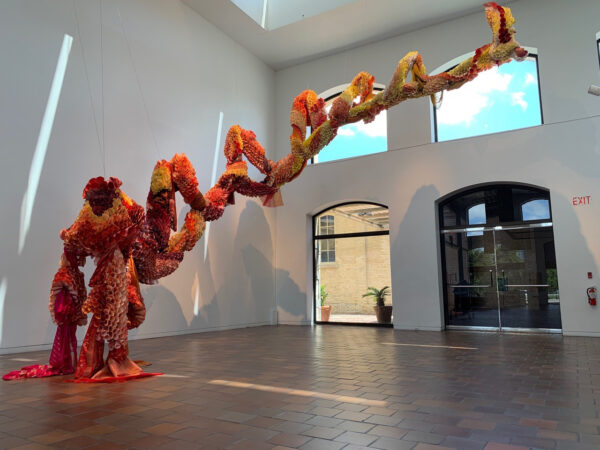
Abhidnya Ghuge, “When He Thought She Could Never,” 2021, 8807 woodblock printed paper plates, wire and 11 donated sarees, installed at the San Antonio Museum of Art as part of the 2021 Texas Biennial. Image courtesy of the artist.
CB: While you make a variety of work, you prefer to create site-responsive installations, such as the piece in the Texas Biennial. What is your motivation behind working site-specific?
AG: For me, the viewer’s participation really completes the pieces. I wanted the viewer’s interaction to be a major part of them. You can’t really walk into a painting or be a part of a sculpture. With an installation, you can become engulfed and interact with it.
I love being able to come into a space, transform it, and provide a unique experience for visitors.
Site-specific installations work two ways; you can change a space using them, and then you can be changed by interacting with them.
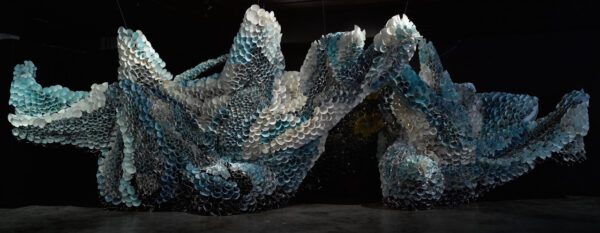
Abhidnya Ghuge, “Unwrapped Saint, Percolated Peace,” 2015, 7883 woodblock printed paper plates and wire, installed at Women & Their Work Gallery. Image courtesy of the artist
CB: To create your installations, you use paper plates as the primary element. What drew you to them? How do you transform them from their original state to what the viewer encounters in one of your installations?
AG: Just as I was beginning my first sculpture class, a friend of mine called from India with tragic news. Her 14-year-old son fell to his death. The idea of him being “disposed of” wrecked me. But after the shock wore off, I came to terms that I will be disposed of one day, as will everyone else who is born. The paper plate became a symbol and metaphor for life.
To transform them, I begin free-handing a design, often incorporating bits of henna designs, on a piece of plywood. The woodblock is then carved and prepped for printing. Before the plates are printed, I often dye them in color baths. Once they are dried, I run them through the press, often letting the ink build up as I go. After the plates are dried, I seal them to be completely archival and stack them in bundles.
CB: Once all of the paper plates are prepared and you are on site, what does your installation process look like?
AG: I walk into a space and spend the majority of the first day getting a feel for it. After I am settled in, I start to work with the wire armature, bending and anchoring it into place. I continue to mold it until it feels right. Once the shape is in place, I start to plug the plates into it with a special fold. As the piece comes together, I edit it by removing sections and reshaping the form. Eventually, the form is filled and complete.
CB: After an installation closes, what do you do with the paper plates?
AG: Just as the memory of a lost loved one lives on, these plates continue on past their “life” as well. I take them and make more permanent works, such as sculptures and wall pieces. They can continue to be enjoyed.
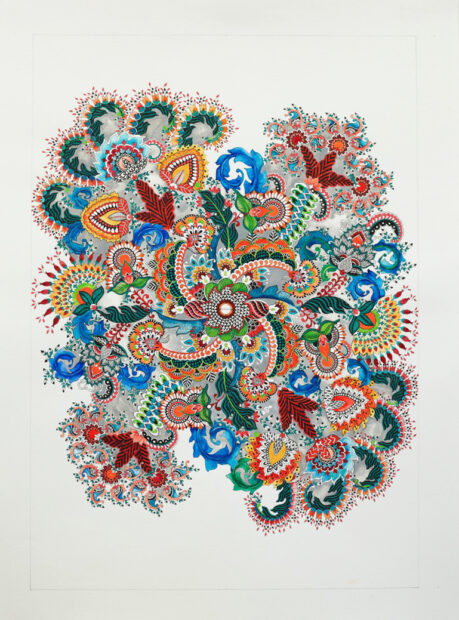
Abhidnya Ghuge, “The Complexity of our Relationship,” 2018, 35 x 27 ½ inches, ink, gouache & watercolor on paper. Image courtesy of the artist.
CB: In addition to those works, you also create mixed-media drawings. Can you talk a little about those?
AG: As I mentioned, I have drawn my entire life. I can’t imagine not drawing. While the designs are fairly abstract in nature, they are portraits of individuals I have interacted with throughout my life, or are my attempts to illustrate specific conversations.
CB: All of your work is fairly complex and layered with meaning. Is there one thing, at minimum, that you hope viewers take away from viewing a piece of yours?
AG: My hope is that viewers will walk away with more of an open mind. After interacting with one of my pieces, I want visitors to be reminded that one should not judge anything based on looks. You don’t really know that my pieces are created out of paper plates until you are up close with them. While the paper plate is often seen as trash, in my works, I transform them into beautiful objects.



3 comments
yes!
Love everything about these installations. Stunning!
Amazing woman with amazing work!!!!!!